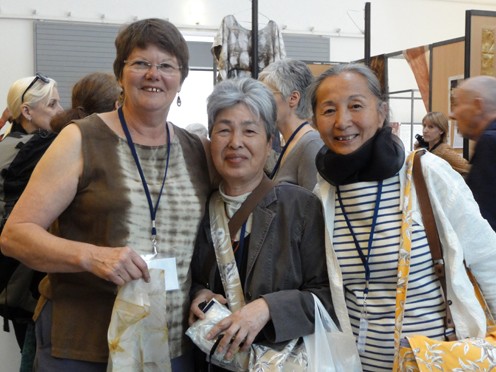An
antipodean dyer at ISEND 2011, La Rochelle, France
By Di
McPherson
Last
April, I attended ISEND 2011 (International Symposium and
Exhibition on Natural Dyes) in La Rochelle, France and
gave a dye demonstration there. The title of my dye
demonstration was "The extraction of dyes from Australian
native plants and the use of shibori techniques to
decorate cotton, silk and wool textiles." It took place in
the large dyeing demonstrations area in the modern Espaces
Congrès Encan, where ISEND 2011 was held. There
were 8-10 flexible cubicles in this area, thus allowing
for simultaneous dye workshops.

Before
leaving Australia I had dried and weighed the foliage from
Excocarpos cupressiformis (native cherry), Eucalyptus
globulus (blue gum) and and Eucalyptus Cordata
(silver gum) to use in my demonstration. I put the Eucalyptus
Cordata leaves to soak in water the day before my
demonstration to ensure the color would be released and
ready for use the next day.
As part
of the symposium, four morning excursions were offered to
attendees. This took place on the same day as my
demonstration. My selected sea-shore visit was informative
and well organized, thus allowing enough time to set up my
dyeing area in the afternoon. I collected the previously
requested equipment from the special store and arranged
the dye pots and gas burners on two individual tables. Two
other tables were pushed together to form a large work
surface, with a few chairs placed around it. A display of
my work on the cubicle walls included pieces with the same
dye colors to be extracted from the leaves—Eucalyptus
cordata, (a brick red color), Eucalyptus
globulus (light brown) and Excocarpos
cupressiformis (yellow). There were samples
illustrating my use of organic and man-made objects to
create patterns: rubber bands, rusty nails, gum nuts, soya
beans, clamps, string, clothes pegs, wire, chop sticks,
and so on. These, and information sheets I had brought
with me were on the table, along with silk, cotton and
mordanted wool for participants to use.
The
very strong aroma of the eucalyptus leaves simmering in my
pots permeated the building, and so, before the official
"starting time", people were flocking to my demonstration
area. They clustered around the pots, curious to see how
the dyes were extracted from the leaves, and asked many
questions about the preparation, time taken, use of
mordants and so forth.

The
time waiting for the dyes to be released provided an
opportunity to demonstrate some simple shibori techniques.
These included using gum nuts tied with rubber bands in a
piece of silk, and inserting and tying rusty objects into
folded cotton fabric.

Many of
the observers stayed and created their own designs. Taking
a piece of fabric and the organic and metallic materials
provided, they then dyed it in the color of their choice.
More people came to look, some of them staying and others
moving on. At one point there were so many people seeking
my attention that I was grateful my husband, Chris Cowles
(who presented a poster to the Symposium), was there to
help me with the dye pots. When the fabric samples began
to run out, those remaining were torn in half, and based
on this, I estimate that there were more than eighty
participants at my workshop demonstration.

Annette
de la Fayette and Dominique Cardon are to be congratulated
on their ability to bring so many people together from
around the world so that we could all experience this
highly successful symposium. My attendance at ISEND 2011
was made possible with the assistance of the Australian
Government's Regional Arts Fund.
Di McPherson and Trudi Pollard

 Turkey Red Journal
Turkey Red Journal
